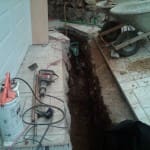 French drain installation
French drain installation
is one of the easiest things you can do to prevent water from entering your home’s basement or crawl space. However, frequently contractors and homeowners neglect to install them when building homes or additions on to homes. The cost of installing a French drain is minimal, as it only requires some perforated PVC piping and ¾ inch crushed stone. French Drains should always be installed around foundations.
A French drain takes advantage of gravity and aids in helping ground water seek lower levels away from your home’s foundation.
A French drain is basically a network of crushed stone and plastic piping that encircles the home or home addition and channels water away from the foundation.
After the home’s footing and foundation walls have been constructed and sealed, several inches of crushed stone should be poured around the outside of the foundation wall near the base of the footings. The crushed stone should be poured such that a natural swale is created towards the lowest expected finished grade around the foundation and abutting yard. This will help aid in the direction of water away from the home.
A small trench should then be extended out into the yard, from this lowest finished grade location at the foundation so that water will continue to drain away from the foundation. The trench should be approximately 1 foot wide and should extend deep enough to enable water to continue to drain from the foundation. The trench should extended outward from this point in the foundation to a distance that the drain reaches the natural ground surface. This will enable the ground water around the foundation water to be effectively channeled out to the surface some extended distance away from the home.
Perforated 4 inch PVC, or similar plastic pipe, should then be placed and connected together on top of the crushed stone with the holes facing downward. It is important for the holes to face downward as water tables build from the bottoms up.
The PVC pipes should be connected such that they funnel water towards the trench and then connect, if necessary with a T-connector, to a straight section of PVC pipe that extends the length of the trench.
With the piping installed, the pipe should be covered with an additional 1-2 feet of crushed stone, less as you work your way out towards the end of the trench.
The foundation can then be backfilled, and 2-4 inches of topsoil can then be installed on top for growing grass.
French drain installations are also common for channeling water from other locations in a yard. Typically they are used in applications where water coming off of a hill would normally drain into a back or side yard. By installing a French drain, the water can be “short circuited” from entering the back or side yard.
For more help on Fench drain systems and building a family room addition, see HomeAdditionPlus.com’s rel=nofollow [http://www.homeadditionplus.com/Room%20Addition%20Bid%20Sheet.htm] Room Addition Bid sheet. The Room Addition Bid Sheet provides you with the knowledge on how to plan a room addition project, and what to look for when hiring contractors for your new home construction. It also includes a detailed cost breakdown table and spreadsheet for estimating your own room addition building costs.
Over the past 20+ years Mark Donovan has been involved with building homes and additions to homes. His projects have included: building a vacation home, building additions and garages on to existing homes, and finishing unfinished homes. For more home improvement information visit http://www.homeadditionplus.com and http://www.homeaddition.blogspot.com
Article Source: [http://EzineArticles.com/?French-Drain-Installation-and-Home-Foundations&id=524379] French Drain Installation and Home Foundations